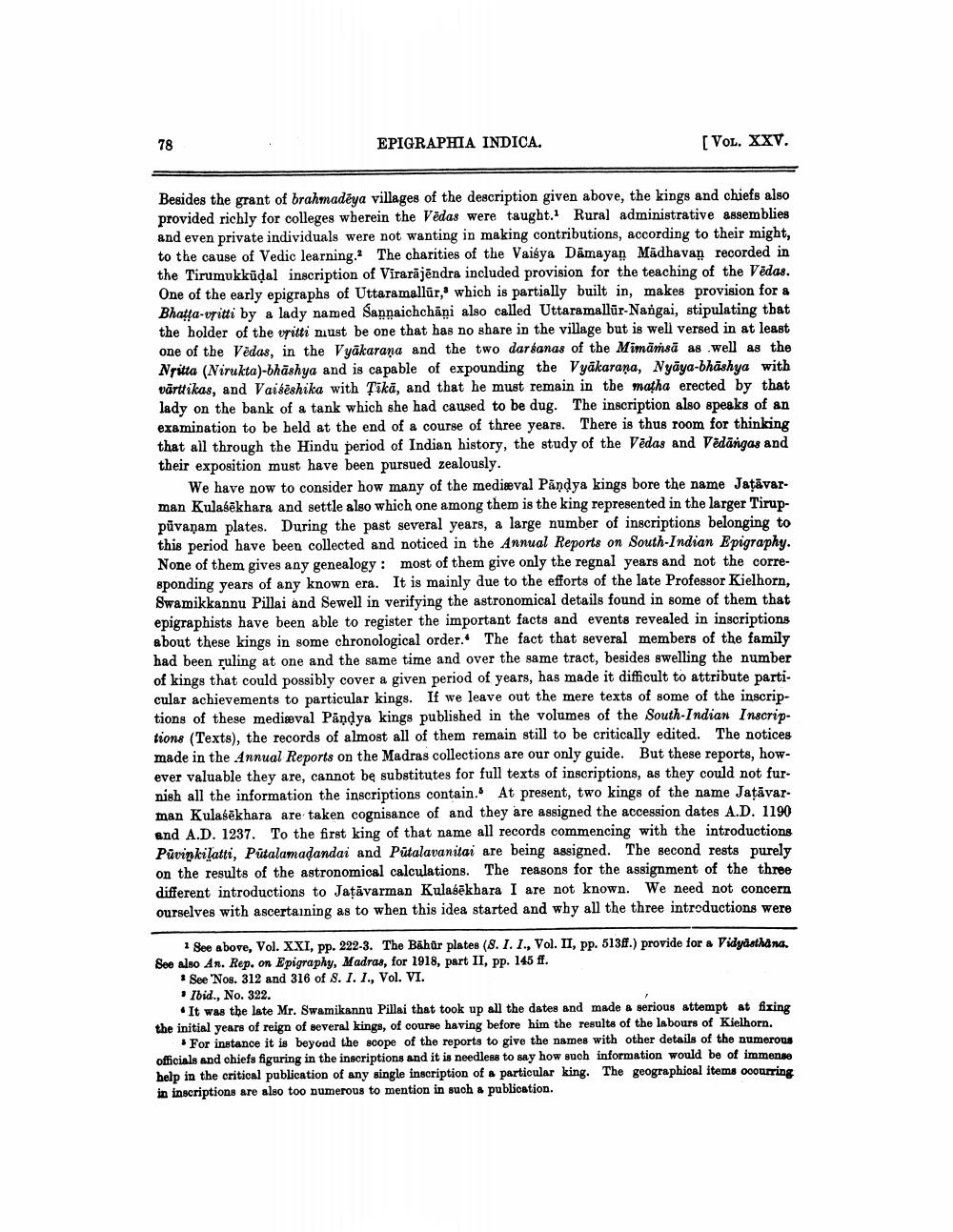________________
EPIGRAPHIA INDICA.
[Vol. XXV.
Besides the grant of brahmadēya villages of the description given above, the kings and chiefs also provided richly for colleges wherein the Vedas were taught. Rural administrative assemblies and even private individuals were not wanting in making contributions, according to their might, to the cause of Vedic learning. The charities of the Vaisya Dāmayan Mädhavan recorded in the Tirumukkūdal inscription of Virarājēndra included provision for the teaching of the Vēdas. One of the early epigraphs of Uttaramallür, which is partially built in, makes provision for a Bhatta-vritti by a lady named Sannaichchāni also called Uttaramallūr-Nangai, stipulating that the holder of the voitti must be one that has no share in the village but is well versed in at least one of the Vedas, in the Vyakarana and the two darsanas of the Mimāṁsā as well as the Nritta (Nirukta)-bhāshya and is capable of expounding the Vyakarana, Nyāya-bhāshya with vārttikas, and Vaibeshika with sikā, and that he must remain in the matha erected by that lady on the bank of a tank which she had caused to be dug. The inscription also speaks of an examination to be held at the end of a course of three years. There is thus room for thinking that all through the Hindu period of Indian history, the study of the Vēdas and Vēdārgas and their exposition must have been pursued zealously.
We have now to consider how many of the medieval Pandya kings bore the name Jațāvar. man Kulabēkhara and settle also which one among them is the king represented in the larger Tiruppūvanam plates. During the past several years, a large number of inscriptions belonging to this period have been collected and noticed in the Annual Reports on South Indian Epigraphy. None of them gives any genealogy: most of them give only the regnal years and not the corresponding years of any known era. It is mainly due to the efforts of the late Professor Kielhorn, Swamikkannu Pillai and Sewell in verifying the astronomical details found in some of them that epigraphists have been able to register the important facts and events revealed in inscriptions about these kings in some chronological order. The fact that several members of the family had been ruling at one and the same time and over the same tract, besides gwelling the number of kings that could possibly cover a given period of years, has made it difficult to attribute particular achievements to particular kings. If we leave out the mere texts of some of the inscriptions of these medieval Pandya kings published in the volumes of the South Indian Inscriptions (Texts), the records of almost all of them remain still to be critically edited. The notices made in the Annual Reports on the Madras collections are our only guide. But these reports, however valuable they are, cannot be substitutes for full texts of inscriptions, as they could not fur. nish all the information the inscriptions contain. At present, two kings of the name Jaţăvarman Kulasēkhara are taken cognisance of and they are assigned the accession dates A.D. 1190 and A.D. 1237. To the first king of that name all records commencing with the introductions Püvinkilatti, Putalamadandai and Pütalavanitai are being assigned. The second rests purely on the results of the astronomical calculations. The reasons for the assignment of the three different introductions to Jaţăvarman Kulasēkhara I are not known. We need not concern ourselves with ascertaining as to when this idea started and why all the three introductions were
1 See above, Vol. XXI, pp. 222-3. The Bahür plates (8.1. 1., Vol. II, pp. 513ff.) provide for a Vidydathana. See also An. Rep. on Epigraphy, Madras, for 1918, part II, pp. 145 ff.
* See Nos. 312 and 316 of 8. 1. 1., Vol. VI. • Ibid., No. 322.
• It was the late Mr. Swamikannu Pillai that took up all the dates and made a serious attempt at fixing the initial years of reign of several kings, of course having before him the results of the labours of Kielhorn.
For instance it is beyond the scope of the reports to give the names with other details of the numerous officials and chiefs figuring in the inscriptions and it is needless to say how such information would be of immense help in the critical publication of any single inscription of a particular king. The geographical items occurring in inscriptions are also too numerous to mention in such a publication.




